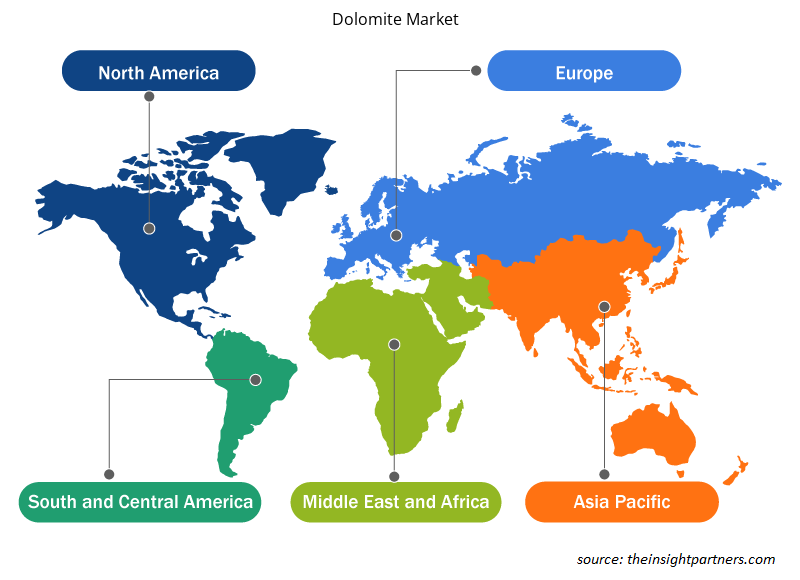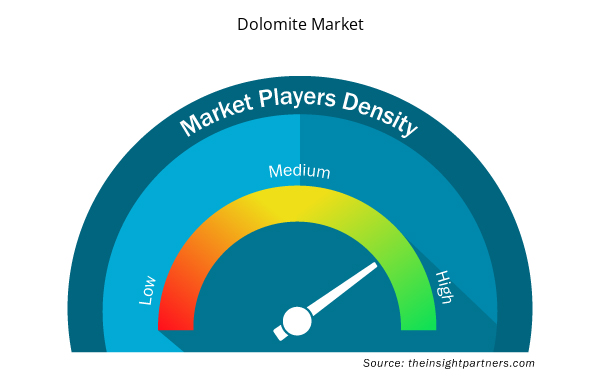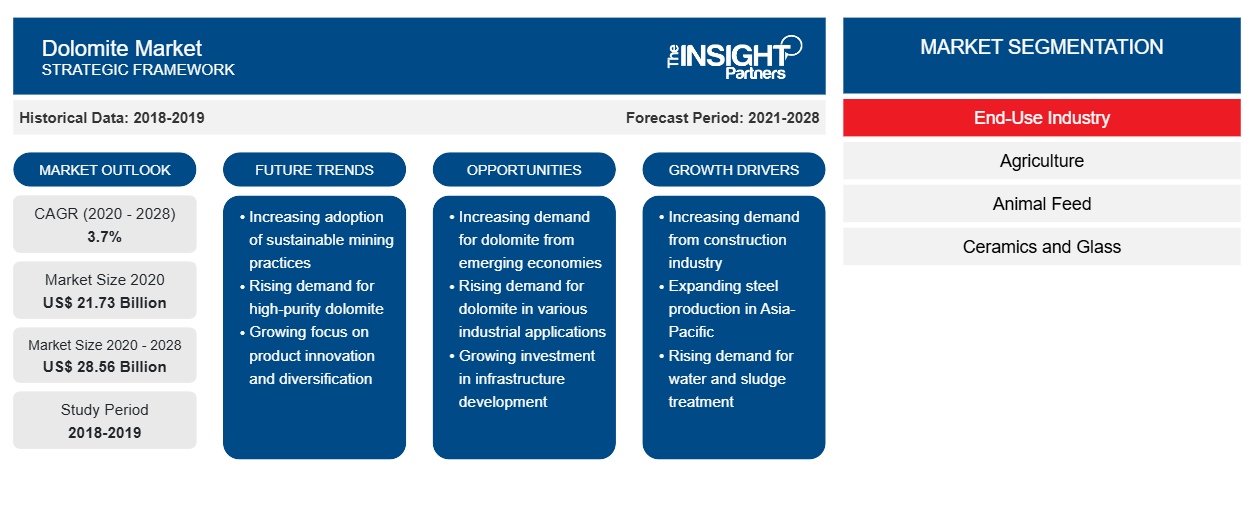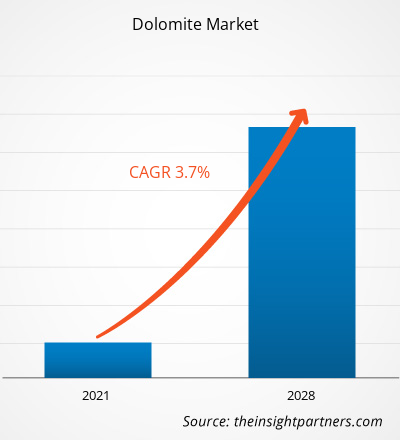Si prevede che il mercato della dolomite crescerà da 21.727,97 milioni di dollari nel 2020 a 28.558,14 milioni di dollari entro il 2028; si prevede una crescita a un CAGR del 3,7% nel periodo 2021-2028.
La dolomite è un materiale importante per le industrie delle ferroleghe ed è ampiamente utilizzata negli impianti siderurgici. Ha anche un'applicazione fondamentale nel settore agricolo grazie alla sua capacità di agire come ammendante del terreno e di bilanciare il pH del terreno. Petrolio e gas, prodotti chimici, gomma, estrazione mineraria e metalli, trattamento delle acque, prodotti farmaceutici e cosmetici sono tra gli altri importanti utenti finali di questa sostanza. Poiché queste industrie stanno assistendo a una crescita considerevole, soprattutto nelle economie in via di sviluppo, anche la domanda di dolomite è in continua crescita. Tuttavia, gli effetti negativi delle attività minerarie sull'ambiente rimangono una preoccupazione per i produttori di dolomite.
Nel 2020, l'Asia Pacifica ha detenuto la quota di fatturato più grande del mercato globale della dolomite . La rapida crescita dell'industrializzazione sta guidando gli investimenti nelle infrastrutture di trasporto in questa regione. Inoltre, un aumento della produzione di refrattari sta spingendo la domanda di dolomite nelle industrie siderurgiche dell'Asia Pacifica. La regione ospita le maggiori economie come Cina e India, che sono tra i maggiori consumatori di refrattari al mondo. La Cina è un importante produttore di acciaio al mondo, mentre l'India sta assistendo a una crescita esponenziale delle infrastrutture. Pertanto, questi fattori stanno offrendo diverse opportunità di crescita per gli operatori del mercato della dolomite nella regione.
Personalizza questo report in base alle tue esigenze
Riceverai la personalizzazione gratuita di qualsiasi report, comprese parti di questo report, o analisi a livello nazionale, pacchetto dati Excel, oltre a usufruire di grandi offerte e sconti per start-up e università
- Scopri le principali tendenze di mercato in questo rapporto.Questo campione GRATUITO includerà analisi di dati che spaziano dalle tendenze di mercato alle stime e alle previsioni.
Impatto della pandemia di COVID-19 sul mercato della dolomite
L'attuale pandemia di COVID-19 ha drasticamente alterato lo stato del settore chimico e dei materiali e ha avuto un impatto negativo sulla crescita del mercato minerario della dolomite. L'attuazione di misure per combattere la diffusione del SARS-CoV-2 ha aggravato la situazione. Settori come l'edilizia e la siderurgia sono stati colpiti dall'improvvisa distorsione delle efficienze operative e dalle interruzioni nelle catene del valore attribuibili alla chiusura improvvisa dei confini nazionali e internazionali. Un calo significativo della crescita di diversi settori industriali ha portato a una riduzione della domanda di dolomite. La chiusura delle attività minerarie ha creato una performance produttiva annuale ostacolata. Gli effetti a lungo termine della pandemia di COVID-19 sull'industria mineraria dipenderanno dalla durata dei periodi di blocco e dalla capacità degli operatori del settore di riprendersi. Poiché molti paesi stanno pianificando di riprendere le proprie attività, si prevede che la domanda di dolomite aumenterà a livello globale nei prossimi mesi. Gli operatori del mercato minerario della dolomite si stanno concentrando sulla disponibilità di forniture e manodopera per raggiungere livelli operativi completi.
Approfondimenti di mercato
Ampia gamma di applicazioni della dolomite per alimentare la crescita del mercato della dolomite
La dolomite ha un ampio spettro di applicazioni nei settori degli utenti finali come edilizia, ferro e acciaio, ferroleghe, ceramica e vetro, agricoltura e mangimi per animali. La sua preferenza e adozione nei settori dipende dal grado della roccia. La dolomite è una sostanza comunemente usata nel settore delle costruzioni per la sua durezza e densità. Nel settore del ferro e dell'acciaio, la dolomite è usata in tre forme: dolomite grezza, dolomite calcinata e dolomite sinterizzata. La dolomite è usata per la neutralizzazione acida nei settori chimici e nei progetti di ripristino dei corsi d'acqua. È anche usata come fonte di magnesia (MgO), un additivo per mangimi per bestiame. La dolomite è usata nella produzione di vetri per auto, vetri da costruzione, fibra di vetro, ecc. Quindi, con la crescita di vari settori degli utenti finali, come edilizia, ferro e acciaio, ceramica e vetro, anche la domanda di dolomite è in crescita.
Approfondimenti sul settore dell'uso finale
In base al settore di utilizzo finale, il mercato globale della dolomite è segmentato in agricoltura, mangimi per animali, ceramica e vetro, ferro e acciaio, edilizia e altri. Il segmento del ferro e dell'acciaio ha detenuto la quota maggiore del mercato nel 2020. L'industria del ferro e dell'acciaio è fortemente guidata dalla crescita di segmenti come difesa, ingegneria pesante, energia ed edilizia. La domanda sempre crescente da parte di questi settori dovuta alla rapida urbanizzazione e industrializzazione, soprattutto nelle regioni in via di sviluppo come Asia Pacifico e America meridionale e centrale, è un fattore importante che contribuisce all'elevata domanda di dolomite nel mondo, che sta stimolando la crescita del mercato.
Tra i principali attori del mercato globale della dolomite figurano Beihai Group; Calcinor; Essel Mining & Industries Limited; JFE GROUP; INCA MINING; LHOIST GROUP; Sibelco; RHI Magnesita GmbH; Arihant Min chem e Omya AG.
Approfondimenti regionali sul mercato delle Dolomiti
Le tendenze regionali e i fattori che influenzano il mercato della dolomite durante il periodo di previsione sono stati ampiamente spiegati dagli analisti di Insight Partners. Questa sezione discute anche i segmenti e la geografia del mercato della dolomite in Nord America, Europa, Asia Pacifico, Medio Oriente e Africa, e Sud e Centro America.

- Ottieni i dati specifici regionali per il mercato delle dolomiti
Ambito del rapporto di mercato sulle dolomiti
| Attributo del report | Dettagli |
|---|---|
| Dimensioni del mercato nel 2020 | 21,73 miliardi di dollari USA |
| Dimensioni del mercato entro il 2028 | 28,56 miliardi di dollari USA |
| CAGR globale (2020 - 2028) | 3,7% |
| Dati storici | 2018-2019 |
| Periodo di previsione | 2021-2028 |
| Segmenti coperti | Per settore di utilizzo finale
|
| Regioni e Paesi coperti | America del Nord
|
| Leader di mercato e profili aziendali chiave |
|
Densità degli attori del mercato dolomitico: comprendere il suo impatto sulle dinamiche aziendali
Il mercato Dolomite Market sta crescendo rapidamente, spinto dalla crescente domanda degli utenti finali dovuta a fattori quali l'evoluzione delle preferenze dei consumatori, i progressi tecnologici e una maggiore consapevolezza dei benefici del prodotto. Con l'aumento della domanda, le aziende stanno ampliando le loro offerte, innovando per soddisfare le esigenze dei consumatori e capitalizzando sulle tendenze emergenti, il che alimenta ulteriormente la crescita del mercato.
La densità degli operatori di mercato si riferisce alla distribuzione di aziende o società che operano in un particolare mercato o settore. Indica quanti concorrenti (operatori di mercato) sono presenti in un dato spazio di mercato in relazione alle sue dimensioni o al valore di mercato totale.
Le principali aziende che operano nel mercato delle Dolomiti sono:
- Gruppo Beihai
- Calcinore
- Essel Mining & Industries Limited
- GRUPPO JFE
- ATTIVITÀ MINERARIA INCA
Disclaimer : le aziende elencate sopra non sono classificate secondo un ordine particolare.

- Ottieni la panoramica dei principali attori chiave del mercato Dolomite
Segnala i riflettori
- Tendenze progressive del settore nel mercato della dolomite per aiutare gli operatori a sviluppare strategie efficaci a lungo termine
- Strategie di crescita aziendale adottate dai mercati sviluppati e in via di sviluppo
- Analisi quantitativa del mercato della dolomite dal 2019 al 2028
- Stima della domanda globale di dolomite
- Analisi delle cinque forze di Porter per illustrare l'efficacia di acquirenti e fornitori nel settore
- Sviluppi recenti per comprendere lo scenario competitivo del mercato
- Tendenze e prospettive del mercato nonché fattori che regolano la crescita del mercato della dolomite
- Assistenza nel processo decisionale evidenziando le strategie di mercato che sostengono l'interesse commerciale, portando alla crescita del mercato
- Dimensioni del mercato della dolomite nei vari nodi
- Panoramica dettagliata del mercato e segmentazione, e dinamiche del settore della dolomite
- Dimensioni del mercato della dolomite in diverse regioni con promettenti opportunità di crescita
Il mercato globale della dolomite è stato segmentato come segue:
Per settore di utilizzo finale
- Agricoltura
- Mangime per animali
- Ceramica e Vetro
- Ferro e acciaio
- Costruzione
- Altri
Profili aziendali
- Gruppo Beihai
- Calcinore
- Essel Mining & Industries Limited
- GRUPPO JFE
- ATTIVITÀ MINERARIA INCA
- GRUPPO LHOIST
- Sibelco
- RHI Magnetista GmbH
- Arihant Min chem
- Omya AG
- Analisi storica (2 anni), anno base, previsione (7 anni) con CAGR
- Analisi PEST e SWOT
- Valore/volume delle dimensioni del mercato - Globale, regionale, nazionale
- Industria e panorama competitivo
- Set di dati Excel


- Employment Screening Services Market
- Aquaculture Market
- Digital Pathology Market
- Playout Solutions Market
- Military Rubber Tracks Market
- Single-Use Negative Pressure Wound Therapy Devices Market
- Excimer & Femtosecond Ophthalmic Lasers Market
- Smart Locks Market
- Trade Promotion Management Software Market
- Tortilla Market

Report Coverage
Revenue forecast, Company Analysis, Industry landscape, Growth factors, and Trends

Segment Covered
This text is related
to segments covered.

Regional Scope
North America, Europe, Asia Pacific, Middle East & Africa, South & Central America

Country Scope
This text is related
to country scope.
Domande frequenti
On the basis of application, construction segment is estimated to register the fastest CAGR in the market over the forecast period. Dolomite is extensively used in the construction sector owing to its hardness and density. Dolomite is utilized for various constructions and building product applications such as asphalt and concrete mixes in a broad variety of building & construction applications such as airport runways, highways, parking lots, curbs, sidewalks, residential streets, roadways, and others. These factors are anticipated to drive the construction segment growth during the projection period.
Wide range of dolomite applications is one of the key drivers for the growth of the global dolomite market. Dolomite has a wide scope of applications in end-user industries such as construction, iron and steel, ferroalloys, ceramics and glass, agriculture, and animal feed. Dolomite is a commonly used substance in the construction industry because of its hardness and density. In the iron and steel industry, dolomite is used in three forms raw dolomite, calcined dolomite, and sintered dolomite. In the iron and steel industry, it is mainly used as a fluxing material for the protection of refractory lining, and as a refractory raw material. Raw dolomite or calcined dolomite is used as a fluxing material. Thus, with the growth of various end-user industries, such as construction, iron and steel, and ceramics and glass, the demand for dolomite is also growing.
China is the leading country of the global dolomite market in Asia Pacific. China is one of the biggest markets for dolomite which is due to the growing refractory production along with the various uses of dolomite in construction and agricultural industry. Manufacturers in China are investing in order to increase the supply of dolomite-based products. Demand for dolomite in China is also increasing which is due to the expansion of crude steel production. Along with this, the increased utilization of dolomite as an aggregator in the construction industry as well as the fertilizer in agriculture industry is driving the growth for dolomite market in China.
Based on application, the iron and steel segment is anticipated to account for the largest share in the global dolomite market. The iron and steel industry is highly driven by the growth of various sectors in such as defense, heavy engineering, energy, and construction. With the ever-increasing demand from these sectors owing to rapid urbanization and industrialization in developing regions such as Asia Pacific, and South and Central America the demand for dolomite is expected to be constantly rise globally.
The major players operating in the global dolomite market are Beihai Group; Calcinor; Essel Mining & Industries Limited; JFE GROUP; INCA MINING; LHOIST GROUP; Sibelco; RHI Magnesita GmbH; Arihant Min chem; Omya AG, and others.
During the forecast period, Asia Pacific is anticipated to account for the largest share in the global dolomite market. Countries in Asia Pacific, such as India, China, Japan, South Korea, and Australia, are witnessing surge in industrialization and urbanization activities. The rapid growth of industrialization is driving investments in transport infrastructure. Further, a rise in refractories production is propelling the demand for dolomite in the iron and steel industries in Asia Pacific. China is a leading producer and consumer of refractories. The growing refractory industry in China, will provide various growth opportunities for the dolomite market players in Asia Pacific.
Trends and growth analysis reports related to Chemicals and Materials : READ MORE..
The List of Companies - Dolomite Market
- Beihai Group
- Calcinor
- Essel Mining & Industries Limited
- JFE GROUP
- INCA MINING
- LHOIST GROUP
- Sibelco
- RHI Magnesita GmbH
- Arihant Min chem
- Omya AG
The Insight Partners performs research in 4 major stages: Data Collection & Secondary Research, Primary Research, Data Analysis and Data Triangulation & Final Review.
- Data Collection and Secondary Research:
As a market research and consulting firm operating from a decade, we have published and advised several client across the globe. First step for any study will start with an assessment of currently available data and insights from existing reports. Further, historical and current market information is collected from Investor Presentations, Annual Reports, SEC Filings, etc., and other information related to company’s performance and market positioning are gathered from Paid Databases (Factiva, Hoovers, and Reuters) and various other publications available in public domain.
Several associations trade associates, technical forums, institutes, societies and organization are accessed to gain technical as well as market related insights through their publications such as research papers, blogs and press releases related to the studies are referred to get cues about the market. Further, white papers, journals, magazines, and other news articles published in last 3 years are scrutinized and analyzed to understand the current market trends.
- Primary Research:
The primarily interview analysis comprise of data obtained from industry participants interview and answers to survey questions gathered by in-house primary team.
For primary research, interviews are conducted with industry experts/CEOs/Marketing Managers/VPs/Subject Matter Experts from both demand and supply side to get a 360-degree view of the market. The primary team conducts several interviews based on the complexity of the markets to understand the various market trends and dynamics which makes research more credible and precise.
A typical research interview fulfils the following functions:
- Provides first-hand information on the market size, market trends, growth trends, competitive landscape, and outlook
- Validates and strengthens in-house secondary research findings
- Develops the analysis team’s expertise and market understanding
Primary research involves email interactions and telephone interviews for each market, category, segment, and sub-segment across geographies. The participants who typically take part in such a process include, but are not limited to:
- Industry participants: VPs, business development managers, market intelligence managers and national sales managers
- Outside experts: Valuation experts, research analysts and key opinion leaders specializing in the electronics and semiconductor industry.
Below is the breakup of our primary respondents by company, designation, and region:

Once we receive the confirmation from primary research sources or primary respondents, we finalize the base year market estimation and forecast the data as per the macroeconomic and microeconomic factors assessed during data collection.
- Data Analysis:
Once data is validated through both secondary as well as primary respondents, we finalize the market estimations by hypothesis formulation and factor analysis at regional and country level.
- Macro-Economic Factor Analysis:
We analyse macroeconomic indicators such the gross domestic product (GDP), increase in the demand for goods and services across industries, technological advancement, regional economic growth, governmental policies, the influence of COVID-19, PEST analysis, and other aspects. This analysis aids in setting benchmarks for various nations/regions and approximating market splits. Additionally, the general trend of the aforementioned components aid in determining the market's development possibilities.
- Country Level Data:
Various factors that are especially aligned to the country are taken into account to determine the market size for a certain area and country, including the presence of vendors, such as headquarters and offices, the country's GDP, demand patterns, and industry growth. To comprehend the market dynamics for the nation, a number of growth variables, inhibitors, application areas, and current market trends are researched. The aforementioned elements aid in determining the country's overall market's growth potential.
- Company Profile:
The “Table of Contents” is formulated by listing and analyzing more than 25 - 30 companies operating in the market ecosystem across geographies. However, we profile only 10 companies as a standard practice in our syndicate reports. These 10 companies comprise leading, emerging, and regional players. Nonetheless, our analysis is not restricted to the 10 listed companies, we also analyze other companies present in the market to develop a holistic view and understand the prevailing trends. The “Company Profiles” section in the report covers key facts, business description, products & services, financial information, SWOT analysis, and key developments. The financial information presented is extracted from the annual reports and official documents of the publicly listed companies. Upon collecting the information for the sections of respective companies, we verify them via various primary sources and then compile the data in respective company profiles. The company level information helps us in deriving the base number as well as in forecasting the market size.
- Developing Base Number:
Aggregation of sales statistics (2020-2022) and macro-economic factor, and other secondary and primary research insights are utilized to arrive at base number and related market shares for 2022. The data gaps are identified in this step and relevant market data is analyzed, collected from paid primary interviews or databases. On finalizing the base year market size, forecasts are developed on the basis of macro-economic, industry and market growth factors and company level analysis.
- Data Triangulation and Final Review:
The market findings and base year market size calculations are validated from supply as well as demand side. Demand side validations are based on macro-economic factor analysis and benchmarks for respective regions and countries. In case of supply side validations, revenues of major companies are estimated (in case not available) based on industry benchmark, approximate number of employees, product portfolio, and primary interviews revenues are gathered. Further revenue from target product/service segment is assessed to avoid overshooting of market statistics. In case of heavy deviations between supply and demand side values, all thes steps are repeated to achieve synchronization.
We follow an iterative model, wherein we share our research findings with Subject Matter Experts (SME’s) and Key Opinion Leaders (KOLs) until consensus view of the market is not formulated – this model negates any drastic deviation in the opinions of experts. Only validated and universally acceptable research findings are quoted in our reports.
We have important check points that we use to validate our research findings – which we call – data triangulation, where we validate the information, we generate from secondary sources with primary interviews and then we re-validate with our internal data bases and Subject matter experts. This comprehensive model enables us to deliver high quality, reliable data in shortest possible time.


 Ottieni un campione gratuito per questo repot
Ottieni un campione gratuito per questo repot